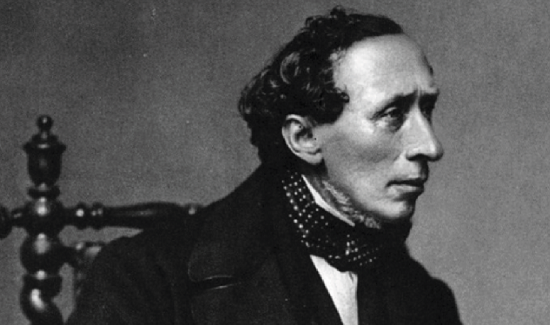THIS WEEK’S MUSE
HANS CHRISTIAN ANDERSEN

“Life itself is the most wonderful fairy tale.”
Hans Christian Andersen’s fairy tales have been translated into over 125 languages worldwide and today are embedded in our collective literary consciousness. He is seen by many as the standard by which good quality children’s literature is judged; by others, that he single-handedly invented modern children’s storytelling.
He was born in 1805 in Odense, one of the largest cities in Denmark and situated on the island of Funen. His parents were extremely poor, sharing a single room and living a harsh, hand-to-mouth existence. Perhaps to escape the poverty, the young Andersen grew up a dreamer and a lover of stories. He learned folk tales from the old women in the spinning room of the asylum where his grandmother worked. “They considered me a marvelous clever child,” he said, “and they rewarded my eloquence by telling me fairy tales.”
At fourteen, he moved to Copenhagen and joined the Royal Danish Theatre. Although the theater didn’t present the career he had hoped for, it helped shape his life in two important ways. First, a friend told Andersen how much he enjoyed his poetry. Encouraged by this, Andersen took his writing more seriously and within a couple of years had published his first story. Second, in 1933, director Jonas Collin persuaded the King to provide a travel grant to enable Andersen to take his first of many trips around Europe. This led to Andersen writing his first travel novel, The Improvisatore, published in 1935 to critical acclaim.
“To move, to breathe, to fly, to float, to gain all while you give, to roam the roads of lands remote, to travel is to live.”
Three collections of fairy tales followed between 1835 and 1837. Critics disliked the chatty, informal style and the humorous but dark immorality that flew in the face of traditional sensibilities. Then, children’s literature was meant to educate rather than entertain, and Andersen’s tales were seen as dangerous and corrupting.
But the critics missed the essential point that children loved the grizzly gore and dark danger Andersen was creating. Sales or success followed quickly. In total he wrote over two hundred fairy tales, almost all published in his lifetime. They were translated across Europe and around the world, making him the best-known Scandinavian writer of his age.
Andersen’s writing style is simple and direct, often containing recurring themes. The rags-to-riches narrative, the support of the underdog, sympathy for the workers or the down-trodden over the oppressive—often “evil”—authority figures, and the romantic, idealized, against the odds, ending. Fictional themes also reflected his own life and self. “Being born in a duck yard does not matter,” he wrote in The Ugly Duckling, “if only you are hatched from a swan’s egg.”
Another recurring theme was his fondness for bringing the inanimate to life—toys, trees, clocks, shadows—or bringing language and humanity to animals. While this approach to storytelling wasn’t of his invention—these literary devices can be found in older folk tales and novels around Europe—he used them so effectively at the heart of his stories, they have become synonymous with his name.
Andersen died in 1875. He knew he was dying and, when discussing the music for his funeral, said “Most of the people who will walk after me will be children, so make the beat keep time with little steps.” Although a prolific adult writer of novels, plays, essays, poetry, and travel, he seems to have been aware then what we all know now – that his legacy lay in writing brilliantly imaginative stories for children.
“The wiser a man becomes, the more he will read, and those who are wisest read most.”
HAPPENING
THE STORY ONLY YOU SHOULD TELL

Friday, April 22 and 29, from 10–11:30am
How to Write Your Own Obituary: The Story Only You Should Tell
With John Parke
Tell your own story how you want it to be told.
$30 – Member, $40 – Non-Member
DETAILS & TICKETS
